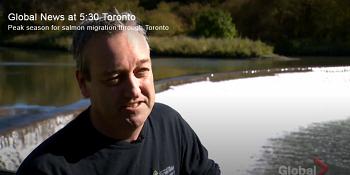It’s peak season for salmon migrating through Toronto-area rivers
For those heading out to enjoy fall colours near Toronto‘s major rivers, look a little closer at the water and you’ll likely see large Chinook salmon heading north as part of the annual spawning process.
Throughout the months of September and October, thousands of salmon migrate north from Lake Ontario — with a percentage of those fish making it as far as the Caledon and York Region areas — to release millions of eggs before the mature salmon die. And the annual process is definitely not an easy one.
During a site visit at Raymore Park, just southeast of Scarlett Road and Lawrence Avenue West, Rick Portiss of the Toronto and Region Conservation Authority (TRCA) showed off one of the Toronto-area fish ladders built to allow the salmon to climb up to an elevated portion of the river.
“When the salmon enter the Humber River, they start down at the lake and they make their way up through all the park system,” Portiss, the senior manager of environmental monitoring projects for the TRCA, told Global News on Friday.
“As they make their way up, they’re jumping over the major dam systems. With [the one at Raymore Park] though, this one has a fish ladder which allows the fish to move around it.
“[Chinook salmon] are one of the largest salmon species that we have in Lake Ontario. The salmon are on average around 20 kilograms and up to a metre long, so they’re quite substantial, they’re quite big and it’s quite impressive to see them swimming through the river system.”
While many may not associate big city living with a massive salmon migration, Portiss said the proximity to Lake Ontario means Toronto and the surrounding municipalities are ideally situated.
“Lake Ontario has quite an extensive fish community, including salmon, and salmon will run up any of those rivers … Where else in the country can you take the streetcar down to see salmon running through a river?” he said while encouraging people to be mindful of pollution.
“As with any natural area or natural systems, stewardship is the best form of protection. Take ownership of the river, don’t pollute the river, treat it as your own.”
For those thinking about fishing, Portiss said it is generally permitted in many areas south of Eglinton Avenue year-round but noted it is illegal to do so within 50 metres of a fish ladder or dam as it’s considered poaching.
Comments
There are 0 comments on this post






